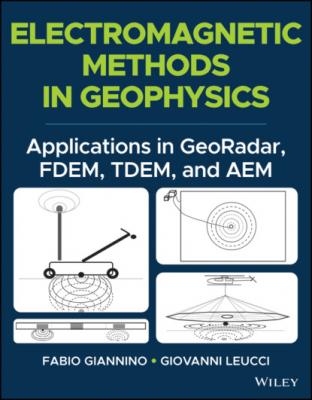ТОП просматриваемых книг сайта:
Electromagnetic Methods in Geophysics. Fabio Giannino
Читать онлайн.Название Electromagnetic Methods in Geophysics
Год выпуска 0
isbn 9781119771005
Автор произведения Fabio Giannino
Жанр Физика
Издательство John Wiley & Sons Limited
In the case of TDEM soundings, on the other hand, it was observed earlier that as time increased, the depth to the current loops increased too, and this phenomenon is used to perform the sounding of resistivity with depth. Thus, Equation (2.3.1) can be inverted to read (since ρ = 1/σ):
(2.3.2)
The voltage induced, and perceived at the receiver coil, is the product of the receiver coil Moment M (Area times the number of turns) multiplied by the time derivative of the vertical magnetic flux density (equation (2.3.3)).
where μ is the magnetic permittivity an M is the transmitter loop moment (L2I) length of the side. This equation gives some important points about transient soundings. Because e(t)IM, is inversely proportional to time and the current diffuse downwards with time, it is more difficult to sound more deeply unless the transmitter moment is increased. To do this one can either increase the transmitter current, the wire turns, or both (Ranieri, 2000). Also, the transmitter loop area determines a deeper exploration depth.
Figure 2.3.6 Scheme of injection of the current with a TDEM system. (a) In the cycle of injection of the current it can be recognized the time‐on, when the current is injected (in one direction and the opposite direction); the time‐off, when the transmitter is switched off and measurements are executed; the Ramp Time representing the time needed by the transmitter to switch off and on completely. (b) It is also illustrated how the induced electro‐motoric force varies during the different phases of the cycle. (c) The schematic variation of the secondary EM field is illustrated, during the phases of the cycle.
As for the investigation depth, this depends upon the geoelectric section explored and its geoelectric characteristics.
On this matter, however, the transient electric field reaches a maximum at the diffusion depth (dd) which is what the skin depth ∂ is to FDEM (Ranieri, 2000):
(2.3.4)
Finally, it is now important to describe a process relating to the following: let us assume that a confined object of given dimension and resistivity is buried in a homogeneous half space at a given depth below ground surface.
At the moment when the primary electric field at the transmitter is off, this will generate a current in the ground (Eddy current) because of its associate magnetic component. At this very time, the current flow shall be distributed solely on the surface of the object mentioned above. The magnetic field in the object shall be exactly the same as that due to the primary. This moment is called Early Time.
From now on, the current starts circulating inward with respect to the object, and the magnetic field is induced by these currents. However, because of Ohmic losses this current starts to decrease (and this is depending on the physical properties of the object). Because of this (and of Faraday’s law for that matter) the magnetic (secondary) field also decreases. This moment is identified as intermediate time.
Figure 2.3.7 Example of decaying curve of the measured tension with time (from Danielsen et al., 2003. With permission of Elsevier)
Figure 2.3.8 Sketch of the decaying curve of the measured tension with time.
At this moment, the current starts to stabilize towards the center of the object, decreasing outwards to the edge of it. At the same time the associated magnetic component starts to decay exponentially with time, with a time constant τ that is given by (McNeill 1980):
(2.3.5)
This moment is known as Late time.
The behavior described above, can be recognized in the 1D soundings as a result of the TDEM survey, and the analysis and forward modeling of the recorded data is addressed at defining a model based on the information that is directly dependent upon the shape, dimension, orientation, burial depth, and electrical resistivity of the target(s).
REFERENCES
1 Giannino, F. (2014). Metodi Elettromagnetici in Geofisica applicata. Acquisizione, analisi e interpretazione dei dati FDEM, TDEM e AEM in ambito geologico, ambientale e ingegneristico. Dario Flaccovio Editore.
2 Menghini, A., Pagano, G., Floris S., et al. (2010). TDEM method for hydrothermal water detection. First Break, Vol. 28. EAGE Publications.
3 Menghini, A. & Viezzoli, A. (2012). Il metodo Airborne EM: un approccio innovativo allo studio del territorio. Geologia Tecnica e Ambiente. Ed. Ordine Nazionale dei Geologi, Roma, MARZO 2012.
4 McNeill, J.D. (1994). Technical Notre 27: Principles and applications of Time Domain Electromagnetic technique for resistivity sounding. Geonics Ltd.
5 McNeill, J.D. (1980). Technical Notre 7: Applications of Transient Electromagnetic Techniques. Geonics Ltd.
6 Nabighian, M.N. (1980). Electromagnetic Methods in Applied Geophysics. Investigation in Geophysics No 2. Volume 2, Application, Parts A and B, ISBN 978‐0‐931830‐46‐4 (Vol.1) 978‐0‐931830‐51‐8. Society of Exploration Geophysics.
7 Parasnis, D.S. (1979). Principles of Applied Geophysics. Third edition, Chapman and Hall.
8 Sharma P.V. (1997). Environmental and Engineering Geophysics. Cambridge University Press.
9 Kearey, P., Brooks, M., & Hill, I. (2002). An Introduction to Geophysical Exploration. Third edition. Blackwell Science.
10 Ward, S.H., & Hohmann, G.W. (1988). Electromagnetic theory for geo¬physical applications. In: Electromagnetic Methods in Applied Geophysics. Volume 1: Theory (ed. M.N. Nabighian), pp. 130–310. SEG.
11 Ranieri, G. (2000). Tem‐fast: a useful tool for hydro‐geological and environmental engineers. Annali di Geofisica, Vol. 43, N. 6, December 2000.
2.4. AIRBORNE ELECTROMAGNETIC (AEM) METHOD: OPERATIVE PRINCIPLE AND THEORY
2.4.1. AEM (Airborne Electromagnetic)
The AEM methods can be considered, as the airborne equivalent of the TDEM (or the FDEM) method, carried out on land. It was developed first for mineral exploration over vast areas in Canada and Australia. For a general overview of the various AEM systems, it is useful to read Siemon et al. (2009).
The methodology is currently not

